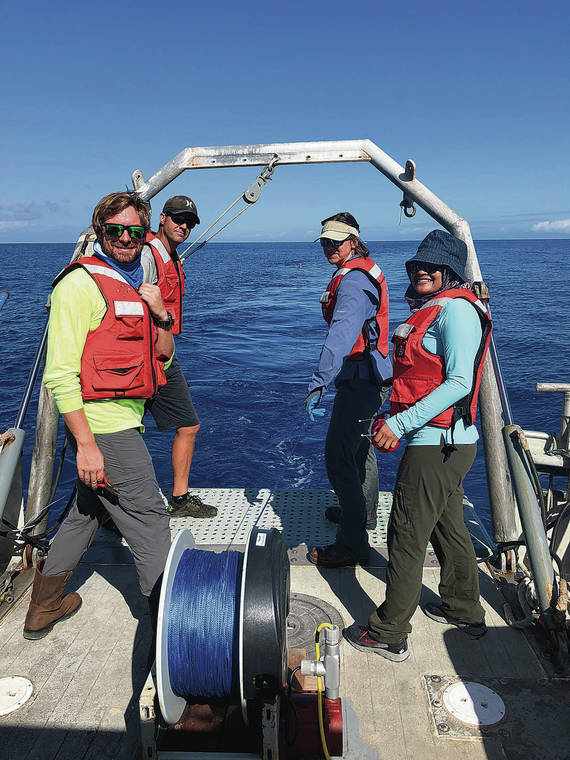By Timothy Hurley
March 31, 2021

COURTESY UNIVERSITY OF HAWAII. Researchers Brendan Hunter, left, Jason Magalen, Dallas Sherman and Khaira Ismail tow electromagnetic imaging technology that mapped out freshwater plumes in the ocean for the first time.
University of Hawaii at Manoa scientists have figured out how to detect and image underwater freshwater plumes rising from the ocean floor, a scientific first that could have wide-ranging implications for oceanography, hydrology and the study of sea life in coastal waters.
The discovery, described in a recent edition of the scientific journal Geophysical Research Letters, could also help water planners to better calculate sustainable yields and aquifer storage levels — increasingly important endeavors as climate change and declining rainfall over time threaten to take their toll on freshwater sources.
The research is the first to demonstrate that surface-towed marine controlled-source electromagnetic (CSEM) imaging — a technology previously deployed for oil and gas exploration — can be used to image oceanic freshwater plumes in high resolution.ADVERTISING
Led by UH research affiliate faculty member Eric Attias, the study is an extension of his 2020 discovery of a vast reservoir of fresh water in the ocean off the western coast of Hawaii island.
Using the same electromagnetic imaging technology that helped reveal the submarine reservoir, Attias was able to map the plumes rising in the water column from the ocean floor.
Going into the research, Attias said he didn’t think he’d be able to image the freshwater plumes since it was never done before.
Emanating from fractures in the basalt, the plumes stretched from seafloor to ocean surface, changing shape with the current. They were found to contain up to 87% fresh water.
The researchers detected more than a dozen strong plumes while towing the CSEM imaging system from a small boat across a 60-square-mile-plus area off West Hawaii.
“The paper only presents four major ones,” Attias said. “I postulate that there is much more around all the island, some small and therefore below the limit of detection.”
A conservative estimate for one of the plumes suggests a volume of 10,720 cubic meters, or about the same amount of water in four Olympic-size swimming pools.
Exactly how these freshwater plumes influence the environment in and around them is unknown. But such high fluxes of water with low temperature and low salinity, high in nutrients and high in carbon dioxide, likely would have substantial effects on biochemical cycles and coastal food webs, scientists said.
“The flux of such high volumes of nutrient-rich, low-salinity groundwater to the ocean has great significance for chemical budgets and providing nutrients for offshore food webs,” UH Manoa Department of Earth Science associate professor and study co-author Henrietta Dulai said in a statement.
Dulai added that knowing the locations of the plumes opens up new opportunities for scientific research, including sampling and identifying the age of the water, its origin, chemical composition and its significance for marine ecosystems in the deep ocean.
Attias said the plumes are indicative of the renewability of the Hawaii submarine freshwater system that he documented in his 2020 study.
That study not only identified a large aquifer of fresh water off West Hawaii, it concluded that it was connected to and fed by Hualalai aquifer. An onshore-to-offshore movement of fresh water was seen through a multilayer volcanic formation of basalts embedded between layers of ash and soil, and through underground lava tubes.
In addition, multiple onshore drilling studies conducted across Hawaii island offered further evidence of the onshore-to-offshore transport of groundwater, according to the study, and helped to account for a previously documented discrepancy between high-elevation freshwater recharge and coastal discharge at Hualalai.
The study suggested that all the Hawaiian Islands — as well as volcanic islands around the world — have similar plumbing with submarine reservoirs and twice as much fresh water for islanders to tap into.
Attias said his team plans to conduct similar studies in the Galapagos Islands to demonstrate that this onshore-to-offshore plumbing is a common feature of all volcanic islands.
Attias will present his work at the virtual International Tropical Island Water Conference, April 12-15. Hosted by the UH Water Resources Research Center and Hawai‘i EPSCoR, this conference brings together water scientists and water managers from around the world to share research and experiences managing and understanding water resources in a range of tropical island settings.
This study was supported by the National Science Foundation and its EPSCoR ‘Ike Wai project.
Read the original coverage from the Star Advertiser at https://www.staradvertiser.com/2021/03/31/hawaii-news/uh-researchers-are-the-first-to-track-freshwater-plumes-rising-from-the-ocean-floor/#story-section
Informing and sharing news on marine life, flora, fauna and conservation in the Galápagos Islands since 2017
© SOS Galápagos, 2021
